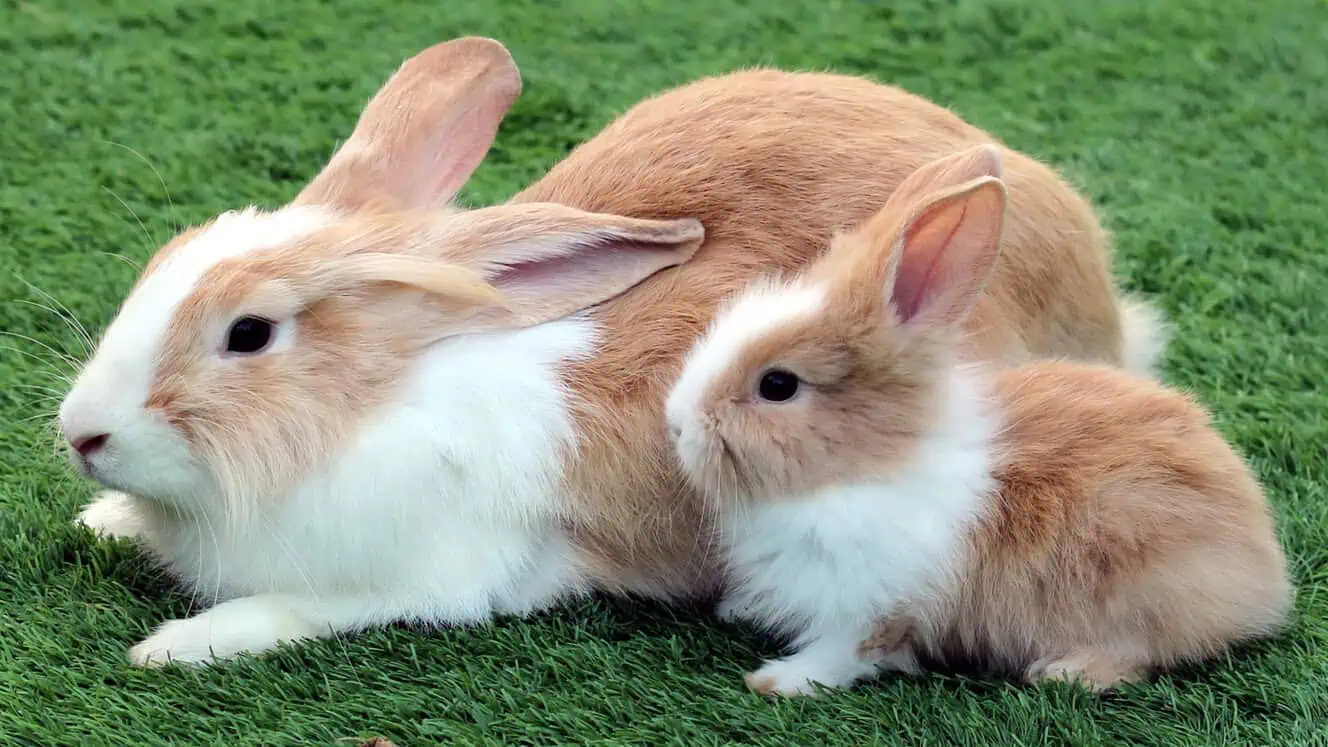
Everyone has their own, unique way of raising their kids – and that goes for small pet mums too. Some small pet mums are very attentive, while others can seem rather aloof. However, whatever parenting approach they use, for small pet mums, it’s all about giving their tiny offspring the very best start in life.
Here, we delve into the fascinating ways that rabbits, guinea pigs, hamsters, chinchillas, degus, gerbils, pet rats and pet mice bring up their babies...
Rabbits and their kits
- Mother rabbits (known as does) are sometimes considered to be rather aloof with their babies. In fact, it’s all about protecting them. Bunny mummies instinctively leave their young alone for long periods of time, but this is so her presence doesn’t attract predators to the nest. The kits will instinctively burrow into the nest to keep warm and remain out of sight.
- Although kits are born blind, deaf and bald, it will only take a few days for some fur to grow and, by 10 days, their ears and eyes will be open, and they’ll be moving around.
- Baby rabbits need to have been weaned before they leave their mother, which is when they’re around eight weeks old. With her now independent offspring successfully reared and ready to go, mum’s job is done.
Find out more about understanding the needs of bunnies, creating an ideal rabbit environment and feeding your rabbits >>
Guinea pigs and their pups
- Baby guinea pigs are born fully formed with hair, their eyes and ears open and able to eat solid food from the day they are born – and their guinea pig mum, who will also feed them with her own milk that’s high in fat and protein, shows them how.
- Within just a few hours, baby guinea pigs become fully mobile and will be popcorning, squeaking, and following their mother around.
- During their first three weeks, as well as nursing them, the mother guinea pig (known as a sow) does a lot of other things for her babies, including stimulating them go to the toilet by cleaning their bottoms periodically throughout the day.
- Young guinea pigs should be at least six weeks old before they’re ready to leave their mother, by which time she will have had enough of nursing her brood!
Find out more about understanding the needs of guinea pigs, creating an ideal guinea pig environment and feeding your guinea pigs >>
Hamsters and their pups
- Baby hamsters are born hairless and helpless and rely on their mum to feed them and keep them warm. At around three weeks, with fur and functioning hearing and eyesight, hamster babies will begin exploring and finding food on their own.
- Hamster babies are carefully cared for by their hamster mother (known as a sow) until they reach about four weeks of age. After this time, she’s had quite enough of motherhood and is likely to try and drive her offspring away, just as she would in the wild.
- This is why hamster babies need to be moved to a separate cage when they are just four to five weeks old for their own safety!
Find out more about understanding the needs of hamsters, creating an ideal hamster habitat and feeding your hamster >>
Chinchillas and their kits
- Chinchillas are born with all their fur and teeth, their eyes open and, within hours, can move around on their own. One of the main jobs for a mother chinchilla (known as a doe) is to keep her babies cosy. Right after they are born, chinchilla kits will crawl under their mother’s body for warmth.
- Chinchilla mums are highly defensive of their babies. If they sense danger, they can behave fiercely, often spitting straight at offending parties as a way of saying ‘back off’!
- Chinchilla babies need to be fully weaned before leaving their mother at between 12 to 14 weeks.
Find out more about understanding the needs of chinchillas, creating an ideal chinchilla habitat and feeding your chinchillas >>
Degus and their pups
- Degus are born fully furred with their eyes open and are immediately mobile. These intelligent animals are curious about everything from the get-go, so degu mums are kept incredibly busy feeding, grooming and keeping tabs on their offspring.
- In the wild, females raise their young in ‘nurseries, with other females in the safety of their underground burrows. So, for a pet degu mum, on her own with five or six pups to care for, it’s a pretty hectic time keeping them all warm, safe and well-fed.
- Helpfully, within just a week from birth, the pups will begin nibbling on solid foods and, by four weeks of age, will be fully weaned.
- During the next couple of weeks, baby degus learn important degu stuff – such as understanding grooming behaviour and how to communicate appropriately with other degus in their colony – this involves play boxing and ‘kissing’ – where they go muzzle to muzzle to learn how to recognise each other. This is an essential learning period which helps them become healthy, happy degus as they grow.
- By around eight weeks, young degus are ready to leave the nest so mum can enjoy some R&R time.
Find out more about understanding the needs of degus and feeding your degus >>
Gerbils and their pups
- Like the young of most small rodents, gerbils are born blind, hairless with their ears closed and are totally dependent on their parents for the first weeks of their lives. Gerbils make excellent parents, with both mum and dad doing a great job of caring for their young.
- A litter of gerbils will normally number between three and six pups – who can be very noisy, especially in the first few days!
- During their first week of life, baby gerbils grow their furry coat. By around two weeks of age, they become very mobile, despite their eyes still being closed, so mum needs to keep a close eye on them! At about two and a half weeks they will pick up things in their environment to test out their teeth and their eyes will open. At three and a half weeks, their ears will unfold and, while still enjoying mum’s milk, they will begin nibbling on solid food.
- At just four weeks old, young gerbils will be fully weaned but will stay with mum for another week or two to learn key life skills to enable them to survive and live healthily – they even pick up what they can or cannot eat from watching their parents and other family members.
- In fact, gerbil families are tight-knit groups. If the mother has had a previous litter, the older babies will help to care for their new, younger brothers and sisters. Gerbil mums also get a helping hand from dad, who will also be involved in the upbringing of youngsters. Gerbil fathers gather nesting materials to protect the babies, clean them, and show them how to gather food and materials for themselves.
Find out more about understanding the needs of gerbils, housing your gerbils and feeding your gerbils >>
Ferrets and their kits
- For the first three weeks of life, ferret kits, which are born blind, deaf and without teeth, are totally dependent on their ferret mother, who will nurse them, see that they are safe and warm and gently carry them around by the scruff of the neck.
- Unlike many animals, a female ferret, or jill, will not refuse her kits after they’ve been handled by humans, and most will accept another jill’s kits easily. Some ferret fans believe that a mother ferret knows exactly how many kits she has and will do a quick count-up when one is not there, refusing to settle until her missing baby is handed back!
- Ferret kits are not ready to leave their mum until they are at least eight weeks old, although some experts prefer for kits to stay with their mothers for as long as possible (up to 11 weeks), because they are still learning lots of essential ferret things from her during this early stage of their life.
Find out more about understanding the needs of ferrets, creating an ideal ferret environment and feeding your ferrets >>
Rats and their kittens
- When rats have a litter, the new-borns may suckle for up to 18 hours a day – which means the mother rat (known as a dam) has to spend quite a bit of time in the nest for the first few weeks after birth.
- Rats are highly intelligent creatures and, if a mother has a particularly large litter, she will split the babies into two piles and nurse them separately, giving all her offspring a chance to feed.
- Rat babies need to be fully weaned before leaving their mother at around six weeks, when they’re ready for their own adventures and mum can take a much-needed break.
Find out more about understanding the needs of pet rats, creating an ideal pet rat habitat and feeding your pet rats >>
Mice and their pups
- Baby mice are called pups (or sometimes pinkies) and are born deaf and blind and so are completely dependent on their mother. The average litter size is 10 to 12 pups – so mum will be very busy!
- Their development is very fast – ears are fully developed at four days old and, by the time they reach 10 days old, they will have grown their furry coat. After two weeks they’ll have a full set of teeth, and their eyes will open.
- By the time they’re just three weeks old, baby mice are ready to wean off mum’s milk and nibble on solid food. At the grand old age of six weeks, they’re ready to leave the nest and strike out on their own – and mum can have a well-earned rest!
Find out more about understanding the needs of pet mice and feeding your pet mice >>
LOVE PETS? TRUST BURGESS – WE’RE EXPERTS IN OUR FIELD!
Burgess Pet Care is one of the UK's leading pet food manufacturers for the country’s most popular pets including rabbits, guinea pigs, chinchillas and degus, hamsters, gerbils and mice, rats and ferrets.
All our high-quality recipes have been formulated by vets and animal nutrition experts. This ensures they contain the right balance of vitamins and minerals to help keep your small pets happy and healthy. With a long tradition of supporting British farmers, we actively source all our ingredients as close to our mill as possible.
For helpful feeding advice, call our expert team on 0800 413 969. They’re available 9am-5pm, Monday to Friday. Alternatively, use our online form to get in touch.
CARE MORE Find lots of useful advice on caring for all your pets from Burgess, the pet experts. Training, nutrition, grooming and general care. It's all here >>
Are your small pets Burgess small pets? Join the Burgess Pet Club for exclusive offers and rewards.
If you found this interesting, you may also like:
SPRING DAYS IN THE SUNSHINE As the days get longer and temperatures creep up, our pets will be eager to get outdoors and enjoy the spring sunshine. However, if you’re thinking of moving your rabbits and guinea pigs outdoors if they’ve spent the winter inside, what are the important things to know?
WHAT’S IN SEASON? HOW TO CHOOSE SAFE FRESH FOOD FOR YOUR SMALL PETS Select safe fruits, vegetables and leafy greens for your small pets to nibble on – you could even forage for some tasty titbits or grow your own!
WHAT PUTS YOUR SMALL PETS IN A GOOD MOOD? Along with socialising with their same species companion and interacting with their favourite human, our survey reveals the best thing you can to do to give your small furries a happiness boost
HOW TO HANDLE SMALL PETS When it comes to being handled, different small pets have very different opinions. Some soon learn to enjoy it – particularly if there are some tasty treats involved! Others are not quite so keen.
WHAT’S THE BEST BEDDING FOR SMALL PETS? Whichever small pets you have, each has different requirements when it comes to creating a cosy, safe, snoozing space.
ESSENTIAL HEALTH CHECKS FOR SMALL PETS Our small pets need us to keep a constant close eye on their health and wellbeing. But do you know what to look for?
WHICH SMALL PET IS RIGHT FOR YOU? Small pets come in all different shapes, sizes and species, so it’s no surprise that choosing the right addition to your family is far from easy. We’ve lots of advice to help you make the best decision...
SMALL PET RESCUE If you’re looking for small pet friends, could a rescue centre be a good place to start? With expert advice on hand, finding your perfect small pet match couldn’t be easier...
WILD AT HEART Many generations ago, the ancestors of our small pets lived in the wild. Understanding how their wild relations live can help us meet our small pets’ needs so they have the right environment, company and nutrition to thrive.
NEW PETS ON THE BLOCK? From dogs to degus, hamsters to gerbils, cats to chinchillas, ferrets to fancy rats – when did these awesome and amazing animals become our furry companions?
FINDING A VET FOR YOUR SMALL PETS Did you know that just like hospital specialists, vets have different areas of expertise? That’s why, if you have small pets, it can be a good idea to seek out a vet that specialises in small animal medicine.
COST EFFECTIVE WAYS TO LOOK AFTER YOUR SMALL PETS From creating DIY boredom breakers to upcycling old furniture and unwanted items from around the house into interesting features for your pets’ environment, here are 8 great ideas for you to try out.
AND SO, TO SLEEP… Are hamsters nocturnal? Do guinea pigs spend more time awake or asleep? Are degus awake in the day? Do chinchillas sleep upside down? Do rats only come out at night? Some of our small pets’ sleeping habits seem a little odd to us, but there are some very good reasons why their snoozing patterns are different to ours, which are really rather fascinating...
BONDING WITH YOUR SMALL PETS Handfeeding is a great way to build a closer bond with small animals. It takes time to build trust, but when your little friend finally feels confident enough to take a treat from your hand, it’s a special moment.
BIG IDEAS FOR SMALL PETS As well as providing the right nutrition, suitable accommodation and company of their own kind, enrichment is just as important for our small pets. But what exactly is it?
HOW TO TELL IF YOU HAVE A HAPPY PET Wheek-wheeking, bruxing, dooking, chirping, binkying, popcorning – there are all sorts of ways our pets tell us they’re feeling good, once you know what to look for...














